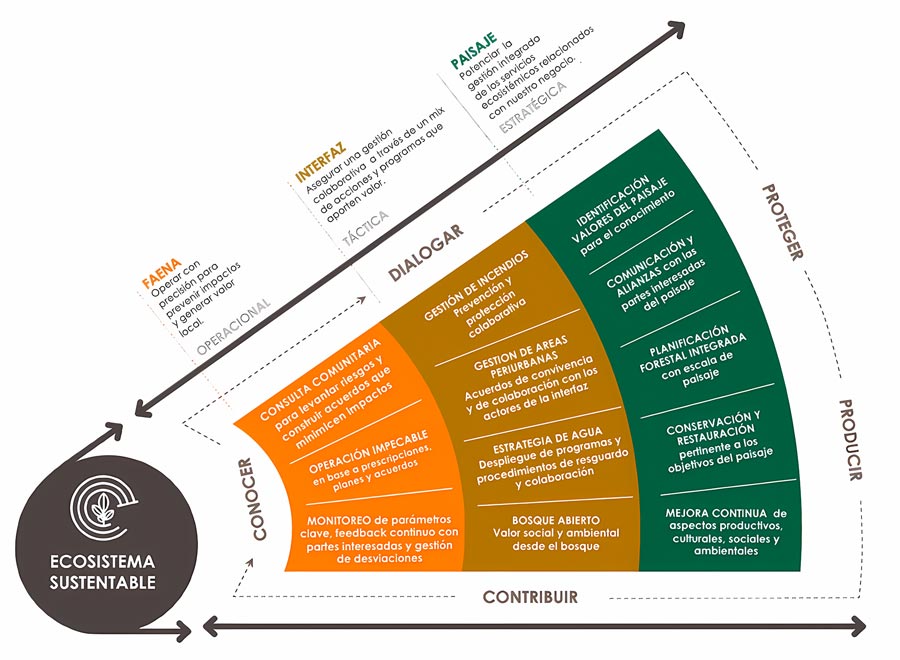
25-01-2024
In our forestry operations, we follow sustainable management principles to promote the biodiversity, productivity, and regeneration capacity of our forests. We look for a balance between economic, social, and environmental aspects. Our plantations are certified under the FSC® (FSC®C108276) and/or PEFC forest management standards, or are in the process of obtaining such certifications.
We guarantee the highest standards of traceability regarding the origin of our wood. All the wood we use is FSC® or PEFC certified, or complies with the FSC® Chain of Custody standard (FSC®C013026) or PEFC Due Diligence requirements. These strategies and practices enable us to ensure that all the wood we use comes from responsibly managed sources, fulfilling our environmental commitments.
Our forestry management is carried out with an integral vision of the landscape, seeking to enhance the natural functions performed by our forests and plantations, such as hydrological cycles and CO2 capture, essential elements for the sustainable development of the planet. We give priority to soil care, ecological conservation and restoration, and the sustainable use of water. We strive to generate social and environmental value by prioritizing ecosystem services, fostering dialogue and participation, and promoting economic and social development in the communities surrounding our operations. In this way, through our forests, we contribute to both people and the planet.
To protect the natural values provided by our forests and plantations, we constantly monitor our operations with landscape impact indicators that combine 6 key factors:
Protecting biodiversity is fundamental for all of society, as it provides functional ecosystems that provide the basic needs of life, such as clean air, water, and food. At ARAUCO, protecting and conserving biodiversity is an integral part of our forestry management, and in 2003 we publicly assumed a voluntary commitment not to substitute native forest and not to encourage substitution by third parties. This has led us to develop protocols and policies that guarantee effective conservation management of native forests.
Good forest management allows trees to be a source of recharge, regulation, and cleaning of aquifers, improving the hydrological cycle in places with plantations and/or native forests. To achieve this, knowledge is central. For this reason, the company has a monitoring network in 16 basins in the country, which enables it to protect more than 45,000 kilometers of watercourses and preserve more than 1,700 hectares of wetlands. To make even more significant progress, for more than nine years ARAUCO has promoted the “Desafío Agua” strategy, through which it has carried out hundreds of projects in 38 municipalities, benefiting more than 50,000 people.
We are the first forestry company to certify its carbon neutrality since 2018. However, since we know this is not enough, we have increased our ambition. In 2022, we submitted our emission reduction targets for Scopes 1, 2 and 3 to Science Base Targets (SBT) and thus, continue to contribute to achieving the global goal of zero net emissions by 2030.
Due to climate change, the risk of forest fires has increased. To address this situation, we have implemented a comprehensive Fire Prevention and Control strategy, focusing primarily on protecting urban-rural interface zones. In addition, we have established a structural network throughout the territory with protection belts in inhabited areas near plantations and industrial complexes. These measures include maintaining a vegetation-free strip, a firebreak strip, and a buffer strip.
Soils are fundamental to the development and productivity of our plantations, as they accumulate water and nutrients. We protect soils for the development and productivity of our plantations. We prevent erosion through mulching and post-harvest care. We recover degraded soils with organic matter. We apply better silvicultural practices to preserve their productivity and characteristics.
Our objective is to contribute to the development of the communities in which we live and work. For this matter, we implement programs that generate significant long-term benefits, using a model based on dialogue and participation to ensure that these initiatives are effective and sustainable
Un paisaje reúne las actividades productivas y áreas de conservación de manera armónica en conexión con el entorno y el desarrollo social de las comunidades vecinas. Dichas actividades son gestionadas mediante un modelo que promueve la integración de elementos característicos de cada zona, como también la colaboración y asociación entre distintos actores del territorio, tanto del ámbito público como privado.
Por tanto, los PPP incorporan la identidad local, los rasgos productivos y otras actividades económicas específicas y tradicionales, como la agricultura, la producción maderera, la industria, la minería y la ganadería. También, se considera a las comunidades y los aspectos socioculturales, así como las consideraciones ambientales.

Para lograr nuestro modelo, hemos dividido nuestro patrimonio en 23 paisajes, considerando sus particularidades territoriales y culturales, además de establecer un modelo de gestión fundamentado en 5 principios:
Desde ARAUCO adoptamos este enfoque con el propósito de gestionar la producción forestal de manera responsable y sostenible, en búsqueda que esta actividad complemente y fortalezca el desarrollo social y ambiental de los territorios. Es así como aprovechamos nuestra experiencia y valores para enriquecer cada región, manteniendo sus tradiciones e identidad características. Establecemos alianzas con actores locales con el objetivo de generar bienestar para los residentes, en términos económicos, ambientales y sociales.
Este enfoque refuerza nuestro propósito como compañía: desde la naturaleza y lo renovable, aportamos a la vida de las personas y al planeta.
La gestión de los Paisajes Productivos Protegidos se lleva a cabo mediante una estructura diseñada para asegurar la conservación y el aprovechamiento sostenible del patrimonio de ARAUCO, teniendo en cuenta las particularidades de cada territorio. Esta estructura opera en tres escalas diferentes:
